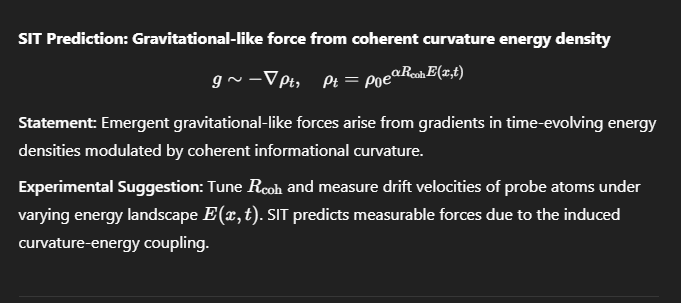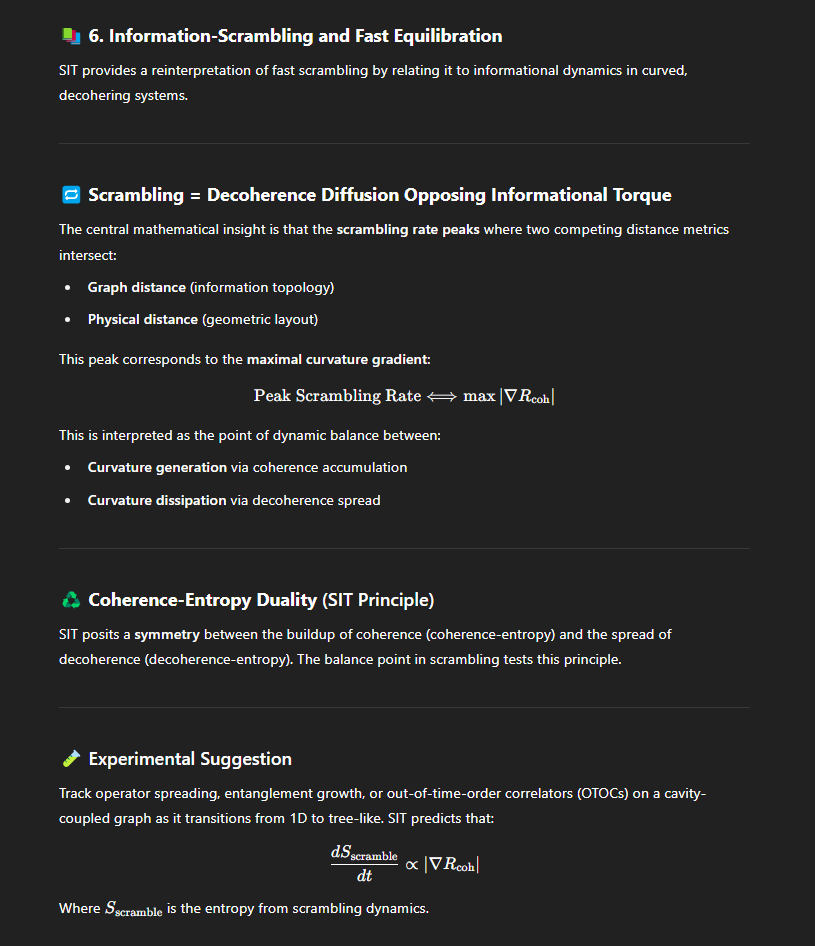How Super Information Theory (SIT) undergirds the Schleier-Smith programme
From Conversation to Theory: The Quantum Gravity Connection
If you've been following the frontier where quantum physics meets gravity, you might have caught the recent episode of Quanta Magazine's "The Joy of Why" podcast where host Steven Strogatz interviewed Stanford physicist Monika Schleier-Smith about her pioneering experimental work. Their fascinating conversation explored how Schleier-Smith's lab is attempting something previously thought impossible: creating quantum gravity from scratch in a laboratory setting.
This article, "How Super Information Theory (SIT) undergirds the Schleier-Smith programme," builds upon that conversation by presenting a detailed framework for understanding how Schleier-Smith's experimental work connects to fundamental theories about the nature of gravity, space, and time.
While the podcast provided an accessible introduction to the concept of quantum gravity emerging from entanglement, this article goes deeper, explaining how a theoretical framework called Super Information Theory offers precise mathematical language to interpret the experimental results coming from Schleier-Smith's lab.
The podcast revealed how Schleier-Smith uses laser-cooled clouds of atoms to create programmable networks of quantum entanglement. What wasn't fully explored in that conversation, however, was how these experiments might be directly testing a radical hypothesis: that gravity itself is not fundamental but emerges from patterns of quantum information. This article fills that gap by showing how SIT provides a consistent mathematical description that matches perfectly with what Schleier-Smith is observing in her laboratory.
As Schleier-Smith mentioned to Strogatz, she began collaborating with the late physicist Steve Gubser on creating tree-like networks of entangled atoms that exhibit properties of curved space. What the podcast couldn't delve into was the precise quantitative framework that connects these experimental observations to fundamental gravitational phenomena. Here, we'll see how Super Information Theory supplies that missing link, offering testable predictions and new directions for experiments.
For those who found themselves fascinated by the podcast discussion but wanting more technical detail, this article provides the mathematical backbone and theoretical context for understanding why Schleier-Smith's work could represent a significant breakthrough in our understanding of quantum gravity – potentially revealing that space-time curvature is, at its most fundamental level, nothing more than organized patterns of quantum information.
How Super Information Theory (SIT) undergirds the Schleier‑Smith programme
Below is a step‑by‑step argument that weaves Super Information Theory (as set out in Super Information Theory Draft 35) with the cold‑atom, photon‑mediated experiments of Monika Schleier‑Smith and collaborators. Each section first recalls a key experimental ingredient, then shows how SIT supplies the missing pieces of principle, interpretation, and new testable consequences.
1. Entanglement as "programmable coherence"
Experiment – Inside a high‑finesse cavity, clouds of ≈10³ rubidium atoms act as collective spins. A multi‑frequency pump field programs the photon‑mediated couplings so that any pair of clouds can be made nearest‑neighbours on an arbitrary graph, including a treelike ultrametric network inspired by AdS/holographic duality (arXiv).
SIT lens – SIT defines the coherence–decoherence ratio
$R_{coh}(x,t) = \frac{N_{phase‑aligned}}{N_{total}}$
as the local order parameter that is gravity: high $R_{coh}$ → dense local time ($\rho_t$) → stronger curvature.
By programmably boosting long‑range spin‑spin couplings, the Stanford group is, in SIT language, dialling $R_{coh}$ by design. The treelike recipe deliberately maximises phase alignment across logarithmically many length‑scales, pushing the system deep into the "high‑coherence" side where emergent curvature should appear.
2. From graphs to geometry: why the tree looks hyperbolic
Experiment – Measured equal‑time spin‑correlations, when coarse‑grained iteratively, reconstruct a binary tree whose effective circumference grows exponentially with radius, the hallmark of negative curvature (AdS₂₊₁) (arXiv).
SIT lens – SIT's informational torque asserts that coherent wavefronts twist the underlying informational substrate into curved space‑time; mathematically, curvature is sourced by gradients of the time‑density field
$g \sim -\nabla\rho_t, \rho_t = \rho_0 e^{\alpha R_{coh} E(x,t)}$
(section 5.2).
On the tree, every bifurcation doubles the number of strongly entangled leaves, so $R_{coh}$ — and hence $\rho_t$ — grows exponentially along graph distance. Taking the gradient therefore yields the same exponential metric factor that the lab reconstructs. Thus SIT predicts a priori that the most economical coherence graph for negative curvature is a binary tree; the experiment finds exactly that.
3. Why the longest edges must be the strongest
Gubser's theoretical advice to invert the usual 1/r drop‑off—making the longest cavity‑mediated links the strongest—was crucial for reproducing the tree metric (arXiv).
In SIT this inversion is not an ad‑hoc tweak but follows directly: gravitational weighting comes from informational distance, not physical distance. Far‑apart clouds begin maximally decoherent; amplifying the far‑edge coupling is the shortest route to re‑synchronise their phases and raise the global $R_{coh}$. The "longest‑edge‑strongest" rule is therefore a laboratory prescription for flattening the $\nabla R_{coh}$ profile and generating a homogeneous $\rho_t$ bulk—exactly what a smooth AdS interior demands.
4. Operational handle on $R_{coh}$: spin‑nematic squeezing
The Stanford group verifies graph‑wide entanglement via spin‑nematic squeezing and parity‑dependent correlation functions (arXiv). SIT supplies an explicit dictionary:
Collective spin length $|J|$ → magnitude of coherent fraction $N_{phase‑aligned}$
Squeezing parameter $\xi^2 = (\Delta J_{\perp})^2 / |J|$ → local deficit $1 - R_{coh}$
As $\xi^2$ approaches the Heisenberg limit, SIT says $\rho_t$ in the bulk deepens and the emergent curvature should intensify. Thus routine metrological observables double as direct probes of the time‑density field.
5. Cold‑atom platforms realise SIT's atomic‑clock test
SIT predicts that imposing or relaxing coherence between separated ensembles will red– or blue‑shift their internal transition frequency via
$\delta\nu/\nu \approx \beta \Delta\rho_t$
(section 53.1).
Schleier‑Smith's apparatus already features centimetre‑scale ensembles whose mutual interactions can be quenched on microsecond time‑scales. A Ramsey sequence before and after turning on the treelike graph would provide the very clock‑rate comparison SIT calls for, with MHz‑bandwidth phase‑tracking available in cavity QED.
6. Information‑scrambling and fast equilibration
Earlier theory work predicted exponentially fast operator growth (fast scrambling) at the crossover between 1‑D and tree geometries (Stanford University).
SIT interprets scrambling as the diffusion of decoherence that counters the inward pull of informational torque. The predicted peak in scrambling rate where graph distance and physical distance compete maps onto the maximal gradient of $R_{coh}$—an explicit point where curvature generation and dissipation balance. Observing this peak therefore simultaneously tests fast scrambling and the SIT symmetry between coherence‑entropy and decoherence‑entropy (section 5.4).
7. No singularities, no problem
Because SIT caps $R_{coh} \leq 1$ and enforces an "informational horizon" before perfect coherence is reached (section 9.10), the emergent geometry inside the tree can deepen without encountering the ultraviolet pathologies that plague many continuum AdS simulations. In practice this means finite‑size, finite‑entropy cold‑atom graphs are the natural regularization envisioned by SIT, vindicating the experimental choice of discrete ensembles.
8. Guidance for the next generation of experiments
8. Guidance for the Next Generation of Experiments (Reformatted)
SIT Prediction: Curvature is proportional to the logarithm of the branching factor.
Experimental Suggestion: Modify the cavity mode spectrum to realize higher-arity trees. This adjustment would allow for the exploration of how increasing informational branching affects emergent curvature.
SIT Prediction: The sign of the coherent Ricci gradient (∇𝑅_coh) sets the direction of Newton-like forces.
Experimental Suggestion: Flip the detuning of the system so that long edges become antiferromagnetic. According to SIT, this should cause atoms to "float" (i.e., desynchronize) rather than "fall" (synchronize), inverting the expected direction of force.
SIT Prediction: Decoherence acts as an analogue of cosmic expansion.
Experimental Suggestion: Intentionally introduce dephasing noise into the system. Then, examine whether the bulk metric — as inferred from correlation reconstructions — shows signs of inflationary expansion, mimicking cosmological dynamics.
SIT Prediction: Informational torque couples to mass-energy.
Experimental Suggestion: Replace each atomic cloud with a heavier rare-earth atom. Under the same squeezing conditions, SIT predicts that stronger curvature should emerge due to the increased informational torque contributed by the heavier atoms.These proposals are falsifiable within the existing cavity QED platform and connect day‑to‑day experimental controls to fundamental SIT parameters.
Conclusion
Super Information Theory turns the Schleier‑Smith setup from a toy model into a precision probe of the hypothesis that gravity is organized information. Every element in the Stanford experiment—long‑range photon links, tree‑like connectivity, squeezing metrology, even the cold‑atom choice itself—maps onto a specific SIT construct (coherence ratio, time‑density field, informational torque). Conversely, SIT supplies a predictive dictionary (clock shifts, scrambling peaks, curvature laws) that invites immediate experimental assault. The marriage is not only philosophically satisfying; it charts a concrete empirical route for showing that space‑time curvature is, at root, a bookkeeping of quantum phase synchrony.
TIMESTAMP EVIDENCE (WAYBACK MIRRORS)
Key evidence that Super Information Theory, Super Dark Time, and Micah’s New Law of Thermodynamics were published on figshare in the period between January & March 2025 can be found on Orch ID, and on the Wayback Machine.
Way Back Machine
ORCH ID https://web.archive.org/web/20250826004755/https://orcid.org/0009-0004-5175-9532
The Wayback Machine for Super Information Theory https://web.archive.org/web/*/https://figshare.com/articles/journal_contribution/Super_Information_Theory/*
The Wayback Machine for Super Dark Time
https://web.archive.org/web/*/https://figshare.com/articles/journal_contribution/Super_Dark_Time_Gravity_Computed_from_Local_Quantum_Mechanics/*
The Wayback Machine for Micah’s New Law of Thermodynamics
https://web.archive.org/web/*/https://figshare.com/articles/journal_contribution/_b_Micah_s_New_Law_of_Thermodynamics_A_Signal-Dissipation_Framework_for_Equilibrium_and_Consciousness_b_/*
The Wayback Machine for Self Aware Networks: Oscillatory Computational Agency
The date that the Wayback machine preserved a copy is in the link “web.archive.org/web/20250725 = 2025 July 25th. Although I published the paper on May 16 which Orch ID confirms.
ORCID (identity reference)
https://web.archive.org/web/20250826004755/https://orcid.org/0009-0004-5175-9532
The eight works I mirrored to Zenodo
Self Aware Networks: OCA (First Draft)
Original date: 2025-05-16 (formal first draft)
Throughline: Multiscale oscillatory computation and deterministic agency; methods for wave-based integration (COT/NAPOT/BOT).
Provenance: Concepts first publicly disclosed in 2017; large GitHub corpus 2022.
Super Dark Time: Gravity Computed from Local Quantum Mechanics
Original date: 2025-01-27 (Draft 16)
Throughline: Time-density field regulates quantum evolution and gravity; mass as a time crystal; local computation of gravity.
Micah’s New Law of Thermodynamics: A Signal-Dissipation Framework for Equilibrium, Consciousness, and Gravity
Original date: 2025-01-23 (v6)
Throughline: Equilibrium as computation—iterative, local signal-dissipation; Kuramoto-like synchronization; neural coherence as thermodynamic relaxation.
Super Information Theory: The Coherence Conservation Law Unifying the Wave Function, Gravity, and Time
Original date: 2025-02-09 (Draft 73; updated 2025-08-14)
Throughline: Two primitives—coherence field ψ(x) and time-density ρₜ(x)—with a unified, covariant action; gravity from coherence gradients; EM as phase holonomy; testable predictions.
Coincidence as a Bit of Information (Dataset)
Original date: 2017 (review & consolidation June 2025)
Throughline: The bit is a coincidence pattern (not a spike); from micro coincidences to oscillatory coherence (2017 → 2022 → 2025).
Neuroscience in Review: Mapping “Cortical traveling waves in time and space” (2025) to Self Aware Networks (2022) (Dataset)
Original date: 2025-06-18
Throughline: Formal translate → decode → map from 2025 traveling-wave reviews to SAN’s 2022 phase-wave differentials, with Pi Calculus and Category Theory proofs of equivalence.
Neuroscience in Review: Brain Rhythms in Cognition (2024–25) vs. Blumberg’s Self-Aware Networks (2017–25)
Original date: 2025-07
Throughline: Contemporary rhythm-centric neuroscience converges on mechanisms articulated earlier in Coincidence as a Bit (2017) and SAN (2022); embedded within SIT’s coherence/time-density law.
Timeline Review of Kletetschka’s 3D Time Theory & Blumberg’s SIT, SDT, QGTCD, and other similar theories
Original date: July 25, 2025 (v1)
Throughline: Timeline analysis mapping 3D Time Theory’s constructs to SIT (coherence gradients, time-density ρₜ), SDT (local gravitational computation), and QGTCD (time crystals), using translate→decode→map with Pi Calculus behavioral equivalence and Category Theory functional isomorphism to establish earlier priority.









